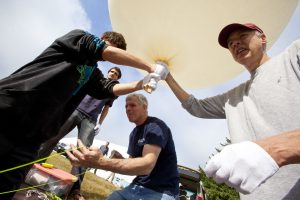Experiment Examples
Send Your Experiment to the Edge of Space with UMaine High Altitude Ballooning!
- Do seeds exposed to that environment grow differently? Compare seeds flown inside the box and those flown taped outside the box with some not flown at all.
- Measure temperature inside two boxes, one empty and one with a chemical hand-warmer (we have temperature loggers and can also provide outside air temperature measurements)
- Send up an ArduinoTM or Raspberry PiTM system (e.g., take your own photographs, measure the environment).
- Send up an experiment that uses an old unused cell phone (you assume all risks if lost). Note that the FCC prohibits you from sending a cell phone signal from aloft.
- Place undeveloped camera film in a sealed container. Cosmic rays at high altitude will reportedly cause white streaks in the developed film.
- Get two matching inexpensive digital clocks. Send one watch up and use the other as a control. Check the times after the flight to see if the cold temperature affected the time.
- Build (or use existing) equipment to measure temperature, pressure, radiation, etc. vs. altitude.
- What happens to a marshmallow at that altitude? How about if it is kept warm inside the box?
- Design an experiment to measure how the elasticity of a rubber band changes after exposure to intense solar radiation
- Would Bubble Wrap bubble pop?
- Would water in a wet sponge boil off due to the lack of pressure? Does keeping it warm make a difference?
- Send up paper that changes color with temperature.
- Send up small rubber balls and do a before and after “bounce test”
- You might convince us to send up a GoPro or still camera to watch your experiment during flight, for example to watch a small balloon expand or keep an eye on a marshmallow.
- This page from NASA might give you some more ideas.
- Here are some ideas for ping-pong ball sized experiments.

